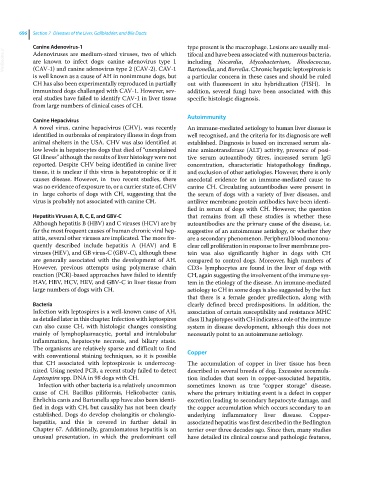Page 728 - Clinical Small Animal Internal Medicine
P. 728
696 Section 7 Diseases of the Liver, Gallbladder, and Bile Ducts
Canine Adenovirus‐1 type present is the macrophage. Lesions are usually mul-
VetBooks.ir are known to infect dogs: canine adenovirus type 1 tifocal and have been associated with numerous bacteria,
Adenoviruses are medium‐sized viruses, two of which
including Nocardia, Mycobacterium, Rhodococcus,
(CAV‐1) and canine adenovirus type 2 (CAV‐2). CAV‐1
a particular concern in these cases and should be ruled
is well known as a cause of AH in nonimmune dogs, but Bartonella, and Borrelia. Chronic hepatic leptospirosis is
CH has also been experimentally reproduced in partially out with fluorescent in situ hybridization (FISH). In
immunized dogs challenged with CAV‐1. However, sev- addition, several fungi have been associated with this
eral studies have failed to identify CAV‐1 in liver tissue specific histologic diagnosis.
from large numbers of clinical cases of CH.
Autoimmunity
Canine Hepacivirus
A novel virus, canine hepacivirus (CHV), was recently An immune-mediated aetiology to human liver disease is
identified in outbreaks of respiratory illness in dogs from well recognised, and the criteria for its diagnosis are well
animal shelters in the USA. CHV was also identified at established. Diagnosis is based on increased serum ala-
low levels in hepatocytes dogs that died of “unexplained nine aminotransferase (ALT) activity, presence of posi-
GI illness” although the results of liver histology were not tive serum autoantibody titres, increased serum IgG
reported. Despite CHV being identified in canine liver concentration, characteristic histopathology findings,
tissue, it is unclear if this virus is hepatotrophic or if it and exclusion of other aetiologies. However, there is only
causes disease. However, in two recent studies, there anecdotal evidence for an immune-mediated cause to
was no evidence of exposure to, or a carrier state of, CHV canine CH. Circulating autoantibodies were present in
in large cohorts of dogs with CH, suggesting that the the serum of dogs with a variety of liver diseases, and
virus is probably not associated with canine CH. antiliver membrane protein antibodies have been identi-
fied in serum of dogs with CH. However, the question
Hepatitis Viruses A, B, C, E, and GBV‐C that remains from all these studies is whether these
Although hepatitis B (HBV) and C viruses (HCV) are by autoantibodies are the primary cause of the disease, i.e.
far the most frequent causes of human chronic viral hep- suggestive of an autoimmune aetiology, or whether they
atitis, several other viruses are implicated. The more fre- are a secondary phenomenon. Peripheral blood mononu-
quently described include hepatitis A (HAV) and E clear cell proliferation in response to liver membrane pro-
viruses (HEV), and GB virus‐C (GBV‐C), although these tein was also significantly higher in dogs with CH
are generally associated with the development of AH. compared to control dogs. Moreover, high numbers of
However, previous attempts using polymerase chain CD3+ lymphocytes are found in the liver of dogs with
reaction (PCR)‐based approaches have failed to identify CH, again suggesting the involvement of the immune sys-
HAV, HBV, HCV, HEV, and GBV‐C in liver tissue from tem in the etiology of the disease. An immune-mediated
large numbers of dogs with CH. aetiology to CH in some dogs is also suggested by the fact
that there is a female gender predilection, along with
Bacteria clearly defined breed predispositions. In addition, the
Infection with leptospires is a well‐known cause of AH, association of certain susceptibility and resistance MHC
as detailed later in this chapter. Infection with leptospires class II haplotypes with CH indicates a role of the immune
can also cause CH, with histologic changes consisting system in disease development, although this does not
mainly of lymphoplasmacytic, portal and intralobular necessarily point to an autoimmune aetiology.
inflammation, hepatocyte necrosis, and biliary stasis.
The organisms are relatively sparse and difficult to find
with conventional staining techniques, so it is possible Copper
that CH associated with leptospirosis is underrecog- The accumulation of copper in liver tissue has been
nized. Using nested PCR, a recent study failed to detect described in several breeds of dog. Excessive accumula-
Leptospira spp. DNA in 98 dogs with CH. tion includes that seen in copper-associated hepatitis,
Infection with other bacteria is a relatively uncommon sometimes known as true “copper storage” disease,
cause of CH. Bacillus piliformis, Helicobacter canis, where the primary initiating event is a defect in copper
Ehrlichia canis and Bartonella spp have also been identi- excretion leading to secondary hepatocyte damage, and
fied in dogs with CH, but causality has not been clearly the copper accumulation which occurs secondary to an
established. Dogs do develop cholangitis or cholangio- underlying inflammatory liver disease. Copper-
hepatitis, and this is covered in further detail in associated hepatitis was first described in the Bedlington
Chapter 67. Additionally, granulomatous hepatitis is an terrier over three decades ago. Since then, many studies
unusual presentation, in which the predominant cell have detailed its clinical course and pathologic features,

